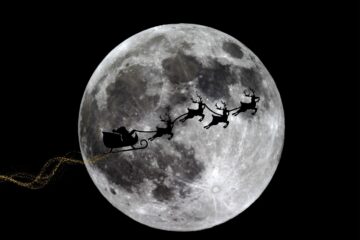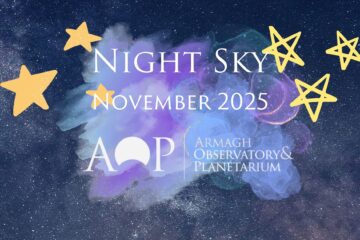October is over, and November is now upon us. The days are definitely getting colder, the night are definitely longer, which means the time for gazing into the night sky is now! One of the best things about November is the fact that there is not one, but two meteor showers to look forward to. So I’ll start out by having a little discussion about them.
The first meteor shower takes place early on in November. The Taurids meteor shower will be at its peak on 4th and 5th November. It’s a long-running minor meteor shower, and produces only 5-10 meteors an hour. We know that meteor showers are produced mainly by the Earth passing through the debris leftover by comets and asteroids. This particular shower is a little different from the others. It actually consists of two separate streams. One is from the Asteroid 2004 TG10, and one is from the comet 2P Encke. Comet Encke is a periodic comet that completes an orbit of the sun once every 3.3 years. Encke was first recorded by Pierre Méchain in 1786, but it wasn’t until 1819 that it was recognised as a comet when its orbit was computed by Johann Franz Encke. A bit like Halley’s Comet, it is unusual that is was named after the calculator of its orbit rather than its discoverer.
The only thing that is going to hinder your observation of the Taurids meteor shower is the presence of the Full Moon in the sky on 4th November. The light of the Moon will flood the night sky, and block out the meteors. The Taurids get their name after the constellation Taurus, in which they radiate from, however you might be able to see some of the brightest meteors from anywhere in the sky.

You can see the point where the meteor shower radiates from November (Credit: Heather Alexander/Stellarium)
The second meteor shower will happen in the middle of November on 17th and 18th. The Leonids meteor shower is an average shower that produces up to 15 meteors per hour at its peak. Its peak is during the night of the 17th November and morning of the 18th November. There will be very little to no moon light in the sky at this time, so it will be a much easier shower to observe when compared to the Taurids meteor shower. This shower is quite unique in that it has a cyclonic peak about every 33 years. When this occurs hundreds of meteors per can be seen per hour. That last of these occurred in 2001. The Leonids is produced by dust grains left behind by comet Tempel-Tuttle, which was discovered in 1865.
On 13th November we will see a conjunction of the planets Venus and Jupiter. In an astronomical sense, a conjunction is the apparent meeting, or passing, of two or more celestial bodies. The conjunction of Venus and Jupiter will be visible in the evening sky, when these two planets will look like they are passing extremely close to one another. At closest approach they will only be about 0.3 degrees apart. Of course, they are well separated in distance, it is only their projection on the sky that makes them appear close together. For the best view of this spectacular sight, it is best to look for the two planets in the east of the sky, just before the sun rises above the horizon, however this will only be visible in certain areas.
On 18th November there will be a New Moon in the sky, and so this would be the best time to gaze at the stars, as there will be no Moon to blot them out. Here is what we recommend looking out for in the south of the sky:
The Pleiades. This open star cluster is one of the many icons of the winter night sky, and will be high enough in the southern sky for a good view. Also known as M45, the Pleiades are made up of middle aged, hot B-type stars and are found within the boundaries of the constellation Taurus. This star cluster was known to many ancient cultures including the Maya and the Aztec. In Japan it is mentioned under the name Mutsuraboshi, meaning “six stars,” in the 8th century Kojiki. It is also known as the name Subaru, which means “to untie.” It was chosen as the brand name of Subaru automobiles to reflect the origins of the firm as the joining of five companies, and is depicted in the firm’s six-star logo.
The cluster itself has a core radius of around 8 lightyears, but its tidal radius is around 43 lightyears. Typically we can only really see with the naked eye 6 or 7 stars in the cluster, however there are over 1,000 stars actually present. The nine brightest stars of the Pleiades are named for the Seven Sisters of Greek mythology: Sterope, Merope, Electra, Maia, Taygeta, Celaeno, and Alcyone, along with their parents Atlas and Pleione.
This would also be a good time to have a look at the constellation Taurus, which is very close to The Pleiades. Taurus is Latin for “The Bull,” and is one of the members of the zodiac. The most famous star in this constellation is the red giant star known as Aldebaran. It is the brightest star in the constellation and the 14th brightest star in the night sky. Located about the tip of the bull’s bottom horn is a brilliant Messier objects. Messier 1 or the Crab Nebula is one of the most famous nebulae out there. The now-current name is due to William Parsons, 3rd Earl of Rosse, who observed the object in 1840 and produced a drawing that looked somewhat like a crab. However in a latter drawing he made it had turned into a bee?! The Crab Nebula is a supernova remnant with an apparent magnitude of 8.4. It is not visible to the naked eye, however if conditions are good it can be faintly made out with a pair of binoculars. At its centre is the Crab Pulsar. This is a neutron star about 20 kilometres across and with a spin rate of a remarkable 30 times per second. Imagine that, a star spinning 30 times per second!!

The amazing Crab Nebula pictured using the Hubble Space Telescope. Can you see the image of a crab? (Image credit: NASA/ESA)
The final thing to mention about this month is that on 24th November Mercury will be at its greatest eastern elongation, when it is furthest from the Sun, as seen from the Earth. When a planet is visible after sunset, it is near its greatest eastern elongation. If it is visible before sunrise it will be near its greatest western elongation. The angle of the maximum elongation (east or west) for Mercury is between 18° and 28°, and this time it will be at 22.0o. The best time to see this will be just after sunset on the 24th November in the west.
Tune in next time for our look at the night sky in December. It will be our last night sky article for 2017! We can’t believe it has come to that time already!
Article by: Heather Alexander





4 Comments
Fire-bred · January 31, 2018 at 03:44
Can you walk on Venus? Walking around on Venus wouldn’t be a pleasant experience. The Venusian surface is completely dry because the planet suffers from a runaway greenhouse gas effect. … Venus’ gravity is almost 91 percent of Earth’s, so you could jump a little higher and objects would feel a bit lighter on Venus, compared with Earth. Admin- do you have an explanation?
admin · January 31, 2018 at 10:10
Hi Fire-bred,
Thanks for the comment. Walking on Venus would be very difficult! It’s all to do with the atmospheric pressure on Venus. At sea level on Earth, the air presses down on our bodies at 14.5 pounds per square inch, or 1 bar; the surface pressure on Venus is 92 bar. To experience that pressure on Earth, you’d have to travel more than 3,000 feet (914 m) down into the ocean. Say someone could dive to the bottom of the ocean (not recommending this!) then the lungs would collapse completely, killing them instantly. So being on Venus would be similar to a human being in a “bottom of the ocean” scenario.
Rakesh yadav · January 4, 2018 at 11:48
nice and learning article. Thanks.
The November Night Sky 2017 – MeasurementDataBases for Industry & Science · November 10, 2017 at 16:25
[…] Astronotes Astronotes: October is over, and November is now upon us. The days are definitely getting colder, […]